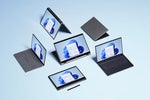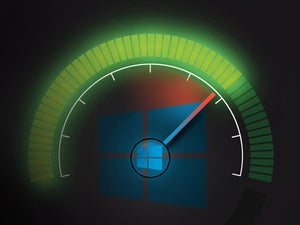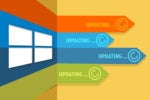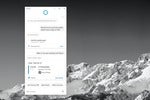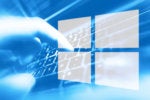Other useful features
Windows 10 has several other interface tricks up its sleeve that are worth knowing about, including the Action Center, People, Task View, Timeline, and a powered-up version of the Windows Clipboard.
The Action Center
In Windows 8, you got to system settings and other behind-the-scenes tools via an awkward interface called the Charms bar. In Windows 10 it's been replaced by the Action Center, which you may or may not find useful. But you should at least know what it is and how it works so you can make your own decision.
There are three ways to launch it:
- Swipe from the right on a touch-based device.
- Click its icon on the far right in the taskbar. (It looks like a rectangular word balloon.)
- Press Windows key + A.
 IDG
IDG
The Action Center springs up with a swipe, a click, or a keyboard combo.
The Action Center is designed for double duty: It displays notifications for such things as your news feed, new emails, and security and maintenance messages, and it lets you change a handful of common settings for such tasks as connecting to Wi-Fi networks, switching to and from tablet mode, and changing brightness settings.
Notifications first appear on their own on the lower right of the desktop and disappear after a few seconds. You may or may not want to click them right away, which is where the Action Center comes in. After they fade away on the desktop, they live on in the Action Center.
Security and system notifications are generally worth heeding. For example, you may be told that you can speed up your PC by stopping unnecessary programs from launching at startup. Tap the notification and you'll be sent to the Task Manager, which lets you stop them from running. The alerts also tell you when you've got printer woes, issues with OneDrive or similar problems. So overall, you'll probably find it worth your time to regularly check the Action Center.
As for email, you might find those notifications less than useful, because the Action Center doesn't always play well with your mail provider. If you’ve set up the Windows 10 Mail app to hook into your Gmail account, you will see a notification in the Action Center when that account gets new email. When you click the notification, the Mail app launches and you can read the message there. But the Action Center doesn’t take into account whether you’ve already checked your Gmail account in a browser, so you’ll continue to see notifications for messages you’ve received, even if you’ve already read them in Gmail and deleted them.
That said, there is a way to suppress Mail notifications from the Action Center, which I’ll cover below.
More useful are the icons for quick actions at the bottom of the Action Center. Just click the icon of the action you want to perform. Most are self-explanatory, such as connecting to a Wi-Fi network or turning Bluetooth on or off.
By default, four icons appear in the top row of the quick-actions area. To show icons for all the quick actions available to you in the Action Center, click Expand just above the row of quick action icons. All of the remaining quick-action icons will appear. The exact icons that appear depend upon the capabilities of the computer that you're using. On a desktop PC, for example, you might only have eight or so quick-action icons, but on a laptop or tablet there will likely be more icons available for options such as Battery saver, Bluetooth, Airplane mode, and so on. To display only a single row of icons when the Action Center is expanded, click Collapse.
To change which ones appear in the row, click the Settings icon on the Start menu, then go to the System group, click Notifications & actions, and look at the area at the top of the screen labeled “Quick actions." Underneath it, click Edit your quick actions. You’ll see all of the quick action icons you have displayed in the Action Center, with a pin on each icon’s upper right. Click a pin to remove its corresponding quick action.
To add quick actions icons, click Add at the bottom of the screen. You’ll see a list of the quick actions you’ve deleted. Click any to add it. When you’re finished, click Done. You can also change any icon’s position in the Action Center: Simply drag it to the location where you want it to appear.
You can also change which notifications show up in the Action Center, or turn them off completely. Click the Manage notifications link at the top of the Action Center or go to Settings > System > Notifications & actions, and to turn off notifications, turn the slider to Off in the “Get notifications from apps and other senders” section. Turn the slider to On to get notifications. Then scroll down and select the kinds of notifications you want to see and turn off the ones you don’t want to see. You’ll be able to choose or hide general types, such as Windows tips or app notifications, or turn off and on notifications from individual apps, including Mail. To do the latter, scroll to the “Get notifications from these senders” section and toggle them On or Off.
You can also set priorities for which apps are more important than others and have their notifications show up at the top of your notification lists. Go to Settings > System > Notifications & actions, then scroll down to the “Get notifications from these senders” section and click an app. A new screen appears that lets you fine-tune how that app’s notifications are displayed. At the bottom of the screen, you'll see settings for three levels: Normal, High, and Top, with Normal being the lowest priority and Top the highest. Choose the one you want.
You can also adjust how many notifications can be visible at any time in the Action Center for any app. The default is three. To change it, from the same screen, click Number of notifications visible in action center, and select a number from the drop-down list (you can choose one, three, five, 10, or 20).
People
People is a useful app that lets you pin contacts to the Windows taskbar, and then communicate with them without having to open a separate app.
 IDG
IDG
With the People app, you can pin contacts to the taskbar to make it easier to contact them in multiple ways.
To use it, click the People button on the right side of the taskbar — it looks like the heads and shoulders of two people. (If the button isn’t visible, right-click the taskbar and from the screen that appears, select the Show People on the taskbar button.)
The first time you use the app, a Get Started button appears. Click it, then click People at the top of the screen that appears. On top of the screen is a list of people you’ve frequently contacted. Click a contact to pin them to the taskbar. (To pin other contacts, click Find and pin contacts at the bottom of the screen. That leads to a search box that lets you search for contacts to pin.)
Once that’s done, the contact is pinned to the taskbar. (To unpin a contact, right-click it and select Unpin from taskbar.) You’ll now be able to communicate with them without having to open a separate app such as Mail or Skype. Just click the icon for the person with whom you want to communicate, and in the contact information page that opens, choose the app you want to use. You’ll be able to get in touch from right inside the contact info page.
You can scroll through your history of communications with the contact. You’ll see all messages you two have exchanged in a threaded list. It includes communications such as Skype video chats and instant messages, not just email.
People also has some drag-and-drop features, including changing the order of contacts on the taskbar by dragging them and sending a file to a contact pinned to the taskbar by dragging the file to that person’s icon.
People lets you pin up to 10 people on the taskbar. Go to Settings > Personalization > Taskbar, scroll down to the People section, and choose the number of contacts you want to show, any number from 1 to 10.
Task View and multiple desktops
Some people might find another Windows 10 feature useful — Task View and its ability to create multiple desktops. Note that the Task View interface is combined with another feature called Timeline.
To activate Task View, click its icon (a rectangle with parts of two smaller rectangles above and below it) in the taskbar just to the right of the search button, or press the Windows key + Tab. When you do so, both Task View and the Timeline feature spring into action on the same screen.
At the very top of the screen you’ll see a “New desktop” button, and beneath that, thumbnails of all of your currently running apps and applications arrayed against the desktop so you can quickly see what you’ve got running. Click any thumbnail to switch to that app or press the Esc key to leave Task View and return to where you were. Beneath that you’ll see Timeline, with thumbnails of documents you’ve run over the last thirty days. (For more details about how Timeline works and how to use it, see its section below.)
For those used to using the old Alt + Tab key combination to cycle through open apps and applications, you can still do that, but Task View adds a couple of extra twists. If you hover your mouse over any thumbnail, a small X appears in its upper-right corner. Click the X to close that app or application.
 IDG
IDG
The top of the screen shows the apps you currently have running (Task View); lower down shows your activity history (Timeline).
Task View also lets you create multiple virtual desktops, each with different Windows apps and desktop applications running on them. To create a new desktop, activate Task View and click New desktop at the upper left of the screen. You can run a different set of Windows apps and desktop applications inside the new desktop — for instance, you could dedicate one desktop to work-related apps and applications, and another desktop to entertainment-related apps and applications.
To switch between desktops, click the Task View icon and click the desktop to which you want to switch. You can keep creating new desktops this way and switch among them.
One odd thing to keep in mind about virtual desktops is that you can’t run a Windows app in multiple desktops simultaneously. If it’s running in one desktop and you try to launch it in another, you’ll immediately zoom to the desktop in which you originally launched it. You can, however, run desktop applications in multiple desktops.
Timeline
Timeline is a feature that lets you review and resume activities and open files you’ve started on your PC. To turn it on, go to Settings > Privacy > Activity history and make sure the box is checked next to “Store my activity history on this device.”
To have activities from other accounts you’ve logged into on your PC show up on your Timeline, go to the “Show activities from these accounts” section and check the boxes next to all the accounts whose activities you want to see on Timeline. And if you want to turn off Timeline, in the “Show activities from these accounts” section, set the slider to off for all your accounts.
You get to Timeline the same way you get to Windows 10’s Task View, as outlined above. Once you’re there, you’ll see a list of your activities day by day for the last 30 days, including files you’ve opened.
 IDG
IDG
The Timeline feature shows your activities in Windows 10 over the last 30 days.
Each activity appears as a large tile, with the name of the application or app that created it at its top, and the file name and document title across it. The history is organized by days, with up to 10 activities for a day visible and with a link at the top of the day giving you the option to see all activities for that day, with the words, for example, See all 12 activities. Click it to see all of them. When you see all of them in a day this way, they’re organized by hour, so for a busy day you can see your work throughout the day, chronologically. To see only 10 when you’re looking at Timeline, click See only top activities.
Scroll through the tiles using a mouse, arrow keys, or the slider on the right-hand side of the screen. You can search through them by clicking the search icon at the top of the screen. But that only searches through titles and file names, not the contents of the documents you’ve opened — so if you’ve worked on a Word document in the last 30 days and it had the word “market share” in the body of the document but not in its title, a Timeline search won’t turn up the document.
Click a tile to open it. In the case of an application, such as Word, the application will launch with the file open in it. When you open a file, it shows the latest version of the file, not the state it was in on that day on the Timeline.
You can remove individual entries from Timeline or all the entries for a single day. Right-click the entry you want to delete and select Remove from the pop-up menu. To delete all of that day’s activities, instead select Clear all from [date] — for instance, Clear all from April 30.
Keep in mind, though, that Timeline has some shortcomings. It tracks primarily Microsoft applications, including all Office applications. Microsoft eliminated Timeline in Windows 11, so it’s unlikely it will ever be updated in Windows 10. In addition, you can no longer share timeline information with multiple Windows 10 devices.
The powered-up Windows Clipboard
The Windows Clipboard, introduced more than 30 years ago in Windows 1.0, has always been underpowered and not particularly useful. But over time, Microsoft has given it some serious attention, and it’s now surprisingly useful.
The new clipboard does much more than merely hold a single clip at a time so you can paste it into a document, which is what the old one did. Now, it stores multiple clips, lets you preview clips and choose which one you’d like to paste into a document, share clips across Windows 10 devices and can even store clips permanently.
You may have to switch these new features on. To do it, go to Settings > System > Clipboard. In the “Clipboard history” section, move the slider from Off to On. If you’d like to sync your Clipboard history across multiple Windows 10 devices, click Get started in the “Sync across devices” section and follow the prompts.
To copy an item to the Clipboard, do what you’ve done in the past: Highlight what you want to copy and press Ctrl + C, or else use an application’s menu, such as Insert > Copy in Office applications. There are other ways as well, such as right-clicking an image on the web and selecting Copy Image from the menu that appears.
After you’ve copied clips into the Clipboard, you can scroll through them, preview them, and choose which to paste into a document. To do it, put your cursor in the location in the document where you want the clip placed. Then press the Windows key + V. A small window appears with the clips you’ve pasted to the Clipboard. Scroll through, and when you find the clip you want to paste, click it. If you only want to paste your most recent clip into a document, just press Ctrl + V as you do in earlier versions of Windows.
 IDG
IDG
The powered-up Windows Clipboard in use.
The clips you save while logged into your Microsoft account are also sent to the cloud and then to the Clipboard of any other Windows 10 devices running version 1908 or later. So they’re always available, no matter which device you’re using.
When you turn off your PC, your clips are deleted. But you can save some permanently. To do it, launch the Clipboard, click the three-dot icon at the top right of any clip and select Pin. That pins the clip to the Clipboard. It stays there permanently until you unpin it.
You can also manually clean out your Clipboard by deleting individual clips or by deleting them all at once. To delete an individual clip, click the three-dot icon at its top right and select Delete. To delete all the clips in the Clipboard, click the three-dot icon at the top right of any clip and select Clear All. Pinned clips won’t be deleted unless you delete them individually.
Keep in mind that the Clipboard has some limitations. It won’t hold any clip over 4MB. You can still copy and paste clips larger than that into documents, but you won’t be able to see and manage them in the Clipboard. And only clips that are 100KB or smaller are shared via the cloud with other devices.
Settings and preferences
In Windows 8, when you wanted to change your settings, you had to look in multiple places and hope you found what you wanted. Windows 10 makes your life easier. Most settings, and particularly the most important ones, are found in the Settings app.
Get to it by clicking the Start button, then clicking Settings.
 IDG
IDG
The Settings app is the control center for all your system settings.
The Settings app has 13 sections: System, Devices, Phone, Network & Internet, Personalization, Apps, Accounts, Time & Language, Gaming, Ease of Access, Search, Privacy, and Update & Security. It's straightforward to use: Click on an icon and navigate to what you need. If you want to get to a specific setting fast, type into the app’s search bar, then click a setting that matches your search — for instance, to turn autocorrect off or on, you can type autocorrect in the search bar, select Autocorrect misspelled words, and drag the toggle switch to the setting you want.
That’s not to say that you'll find everything in the Settings app. If you’re looking for something that only a tinkerer might want to change, you might find it instead in Control Panel. So, for example, if you want to assign your PC a static IP address, have your system display files that are normally hidden, or access similar techie settings, Control Panel is the place to go.
You can get there by typing control panel in the Settings app’s search bar and selecting Control Panel. Here you can navigate through the groups or search for your task. For instance, typing hidden in the Control Panel's search bar turns up “File Explorer Options: Show hidden files and folders.”
Security settings
In Windows 10, all of your most important security settings are found in a single location, Windows Security. Get to it by going to Settings > Update & Security > Windows Security.
From here you can change all your important security settings. You likely won’t need to do that, though, because the default Windows settings are solid. However, if you’re looking for advanced customization options, such as letting apps through the built-in firewall (get to this setting from the “Firewall & network protection” section), here’s where to go.
And if you’re worried about ransomware, you can turn on an anti-ransomware capability called Controlled Folder Access, in which only approved apps can get access to Windows system files and data folders. To turn it on, in Windows Security select Virus & threat protection. Scroll down to the “Ransomware protection” setting and click Manage ransomware protection. At the top of the screen that appears, you’ll see the “Controlled folder access” section. Move its slider to On.
When you do that, you’ll also be able to customize how it works, including changing which folders should be protected and which apps should be allowed to access them. Click Protected folders to add a folder you want protected. (Note: You can’t remove the ones that Microsoft protects by default.)
 IDG
IDG
Controlled Folder Access protects against ransomware by allowing only vetted apps to access important folders.
If you instead want to add an app that can access the folders, click Allow an app through Controlled folder access, then click Add an allowed app. When you do that, you have two choices: “Recently blocked apps” or “Browse all apps.” Click Recently blocked apps if Controlled Folder Access has blocked an app you want to let through. You’ll see a list of apps. Select the ones you want to allow through.
If you want to add an app that hasn’t been recently blocked, click Browse all apps. You’ll have to know the location of the executable file that runs the app. Navigate to the file, select it, and it will be allowed through.
Handy touchpad gestures, keyboard shortcuts, and touchscreen gestures
Windows 10 supports a variety of keyboard shortcuts as well as gestures for touch-based devices. Try them out a few times, and before long they'll become second nature.
First, let's look at touchpad gestures. Touchpads are standard equipment on laptops these days, and for everyday computing a modern touchpad can do everything a mouse can, and more. (Note, however, that if you have an older machine, some or all of these gestures might not work.)
Next up are the most useful keyboard shortcuts — get to know these and you'll save oodles of time as you zip around Windows 10 without taking your hands off the keys.
Finally, if you're working on a tablet or a touchscreen PC, here's how to get around.
This article was originally published in December 2015 and most recently updated in December 2023.







